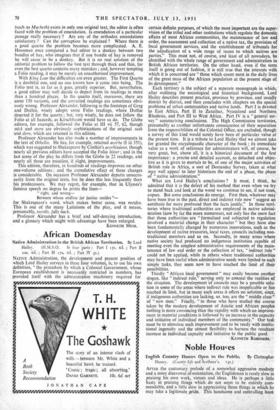Noble Howes
AFTER the customary prelude of a somewhat aggressive modesty and a noisy disavowal of•ostentation, the Englishman is rarely slow in praising his own work, virtues and ideas. He is perhaps a little hasty in praising things which do not seem to be entirely com- mendable, and a little slow in appreciating Those things in which he may take a legitimate pride. This handsome and enthralling book will serve.to stimulate our pride and interest in the great houses of our land ; and here indeed is an architectural achievement which is distinctively English. These houses represent a way of life that was evolved and enjoyed by a relatively small number of English- • men, but they represent also, in a far wider sense, a manifestation of the insular genius.
It is true that some of our great houses were designed or decorated by Continental architects. These (for example, Clandon Park) are • never so impressive or so gracious as those which reveal the native genius of such men as Inigo Jones, Wren, Vanbrugh, Campbell, Chambers, Kent, the Woods of Bath and Robert Adam. The excel- lent photographs in this book illustrate the great country house in all its phases, from the days of the fortress and the abbey to the days of Grecian elegance. Neither the photographs nor the houses are of equal merit, but the whole series forms a conspectus of styles, alike of exteriors and interiors, that is entirely delightful. Mr. Hussey's introduction has the unusual fault of being too short ' • it is lucid and informative, and most readers, I think, would have liked a great deal more of it. The hisfOrical notes which accompany the illustrations are very much to IhE point, although such enforced brevity has its disadvantages.
No doubt it would be possible, in a few cases, to question the selection of the photographs—some of which, incidentally, appear to be not very recent. Newstead is represented only by a very constricted picture of the Tudor fountain; which gives no impression of the abbey as a whole and its firie gardens. In general, a few photographs of a less formal kind might have been welcome ; and it always seems to me that the absence of the human figure in this kind of photography is much to be regretted. Still, it would admittedly be difficult to introduce appropriate figures in such magnificently ornate and aristocratic interiors as the state drawing- room at Chatsworth the " cedar room " at Warwick, or the chaste elegances of Osterley and Syon. In the cane of exterior views, and especially of gardens, it is far othlVige ; and here the introduction of a few unobtrusive people would give both kale and vitality to the scene. But this is a general- criticism which applies equally to that admirable series of pictures for which Country Life is justly celebrated. With all their occasional extravagances and oddities the houses here depicted are noble indeed, attcl it is observable how, with a very few exceptions, the owners haWpreserved the original character of their interiors. To be permittig to see these magnificent homes is a privilege to be enjoyed with wifitude ; and for those who cannot see them this book is by no means an imperfect substitute for direct experience. It will provide endless pleasure, both for the Englishman and for those who are now visiting his country. C. E. VULLIAMY.







































 Previous page
Previous page